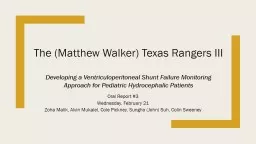

Developing a Ventriculoperitoneal Shunt Failure Monitoring Approach for Pediatric Hydrocephalic Patients Oral Report 3 Wednesday February 21 Zoha Malik Alvin Mukalel Cole Pickney Sungho ID: 808553
Download The PPT/PDF document "The (Matthew Walker) Texas Rangers III" is the property of its rightful owner. Permission is granted to download and print the materials on this web site for personal, non-commercial use only, and to display it on your personal computer provided you do not modify the materials and that you retain all copyright notices contained in the materials. By downloading content from our website, you accept the terms of this agreement.
Slide1
The (Matthew Walker) Texas Rangers IIIDeveloping a Ventriculoperitoneal Shunt Failure Monitoring Approach for Pediatric Hydrocephalic Patients
Oral Report #3
Wednesday, February 21
Zoha
Malik, Alvin
Mukalel
, Cole Pickney,
Sungho
(John) Suh, Colin Sweeney
Slide21/1000
live births in the US
Cerebrospinal fluid drains in the brain at 600-700 ml/day (0.2-0.7ml/min)CSF drainage from the brain is blockedLeads to build up of CSF:Ventricles enlargeBrain swells upIntracranial pressure increases Critical at +5mmHg or more- Loss of vision, headaches, neurological damage or death
Hydrocephalus
Image source: http://r3.emsworld.com/files/base/image/EMSR/2013/09/16x9/1280x720/hydrocephalus-fnl_11140875.jpg
Slide3Gold standard for 50+ years
Shunt surgically inserted:
Proximally: into third ventricleDistally: Into peritoneal cavityHowever…50% shunts fail within 2 years of implantationCurrent Solution: Ventriculoperitoneal Shunts
Image source: http://umm.edu/~/media/ADAM/Images/en/12726.ashx
No means of detecting shunt failure:
Symptoms & damage before shunt replacement
Unnecessary replacement surgeries
Proximal failure
Distal failure
Slide4Project Objective Statement
Measure the
differential pressure between the shunt and the brain for proximal failure detection:If there is no difference: there is no proximal failureIf there is a difference, there is proximal failureOptional distal pressure measuring component for distal failure detectionRemotely communicate when the shunt failsThe solution:Must detect shunt failure before patient develops neurological symptoms Must remotely communicate failure with minimal error The Need
ΔP
Communicate
Slide5“Smart Shunt” Design
Slide6Current Iteration of Design Components
Issues:
Transduction method highly complex – beyond scope of our capabilitiesExternal device is large and requires large amount of power – does not fulfill our need for monitoring in non-clinical setting
Slide7Radio Frequency Identification (RFID) Communication
RFID uses electromagnetic waves to exchange data between an interrogator and the transponder
Transponder is generally composed of an integrated circuit for storing and processing the data signal and an antenna for receiving power and transmitting the signalThe electromagnetic field received from the interrogator is the only source of power to the passive transponderInterrogatorTransponderIntegrated Circuitry
Digital Signal Processing& Display
Demodulation
Skin
Power
Signal
ADC
Signal Conditioning
Catheter
CSF Flow
Pressure Sensor
f
r
=
f
r
Slide8RFID Communication
Telemetric Intracranial Pressure Monitoring with the
Raumedic Neurovent P-telSource: Raumedic AGBenefits: RFID technology currently being used in FDA-approved continuous ICP monitorNo need for on-board power supplyNo potential leakage of battery componentsIncreased failure detection lifetime At-home recording possible
If multiple sensors are employed, modules can be configured to transmit information sequentially to ensure signal trains do not interfere
Proposed Multi-Sensor unit with multiple RFID sensing points.
Source: Patent US20090204019 A1.
Slide9Arduino Implementation
Pressure Sensor
Slide10eZ430-TMS37157
PC
RFID ReadereZ430-TMS37157
Pressure Sensor
Slide11Strain Gauges: PDMS Window
Pore Diameter: .85 mm
# Pores: 24
# Removed Pores: 4
Drainage Surface Area:
64.1 mm
2
% Reduction of Drainage Surface Area After Modification:
16.7%
1.45 mm
2.70 mm
.625 mm
2.70 mm
1.0 mm
7.5 mm long
Strain Gauge
Proximal End
Slide12Future Directions
Separate into development teams
Order microstrain gaugeOrder Arduino + decide on NFC tagApp DevelopmentPDMS + Strain Gauge Mechanical TestingFatigueStress-Strain Curve2.3 mm6.1 mm
Slide132016
2017
Today
Nov
Dec
Jan
Feb
Mar
Apr
2016
2017
Semester 1 Ends
12/19/2016
Semester 2 Begins
1/9/2017
Design Day
4/24/2017
7 days
Dec 9 - Dec 19
Finalize Semester 1 Work
15 days
Dec 19 - Jan 8
Winter Break
15 days
Jan 8 - Jan 27
Determine pressure sensing mechanism
11 days
Jan 25 - Feb 8
Construction of physical model
11 days
Feb 8 - Feb 22
Testing of pressure sensing in physical model
10 days
Feb 22 - Mar 7
Revisions of design
16 days
Mar 7 - Mar 28
Long term testing until shunt failure
20 days
Mar 28 - Apr 24
Final Revisions
12 days
Apr 7 - Apr 24
Preparation of design day deliverables
Gantt Chart